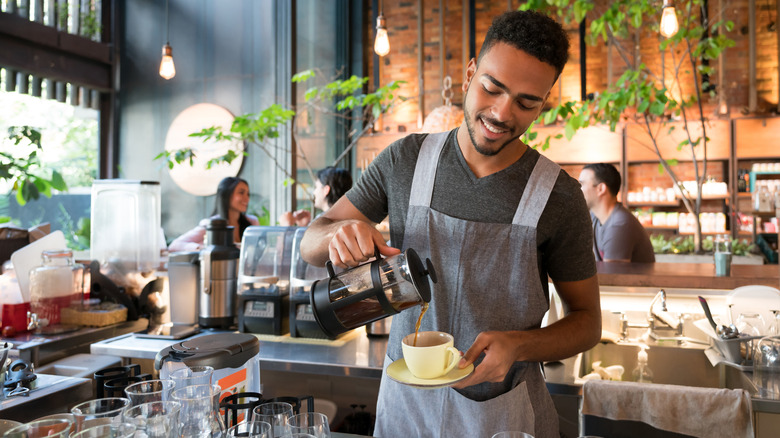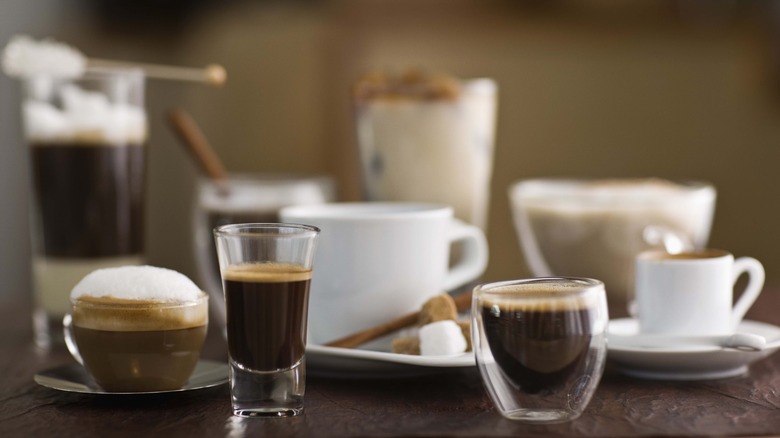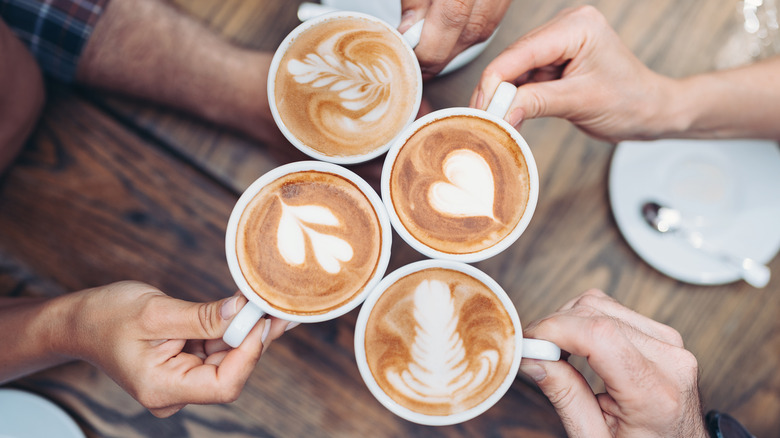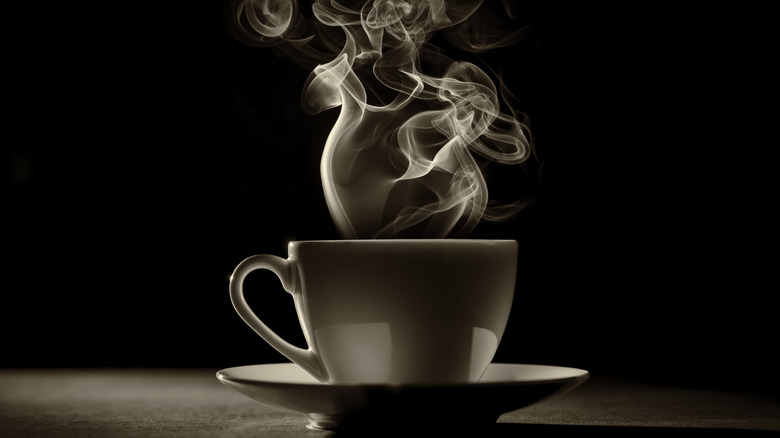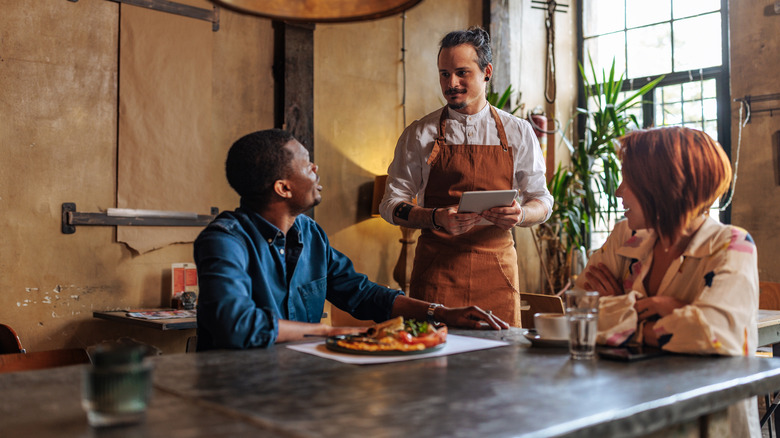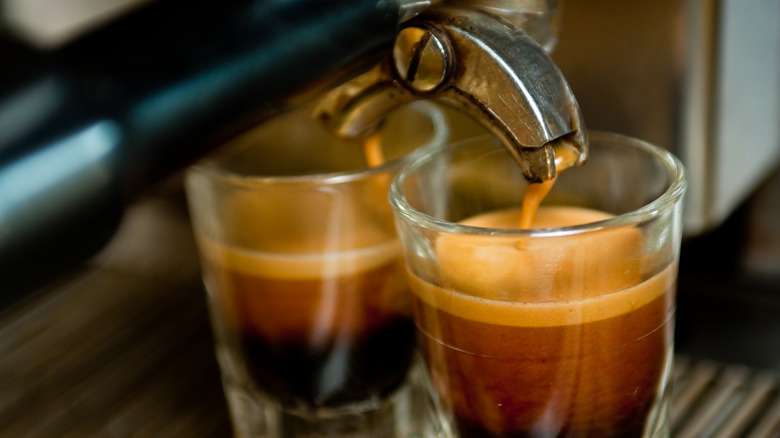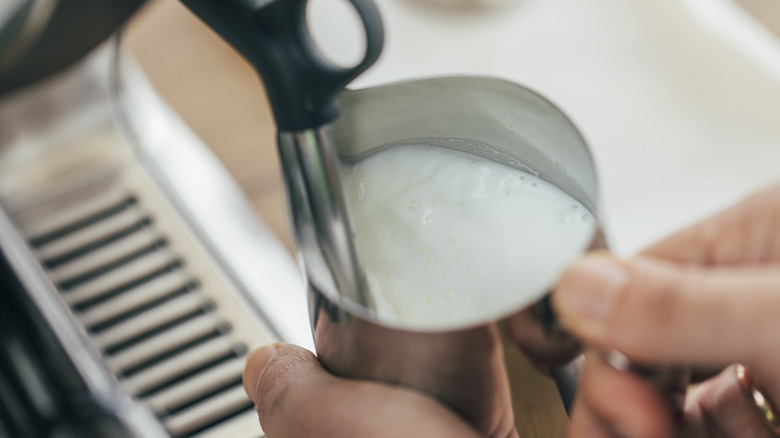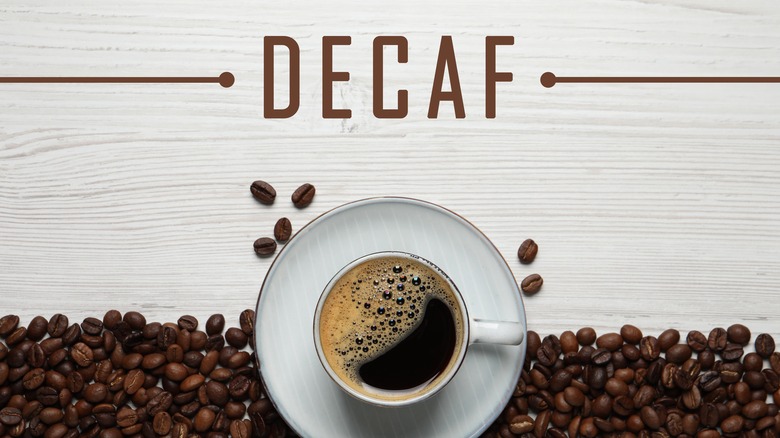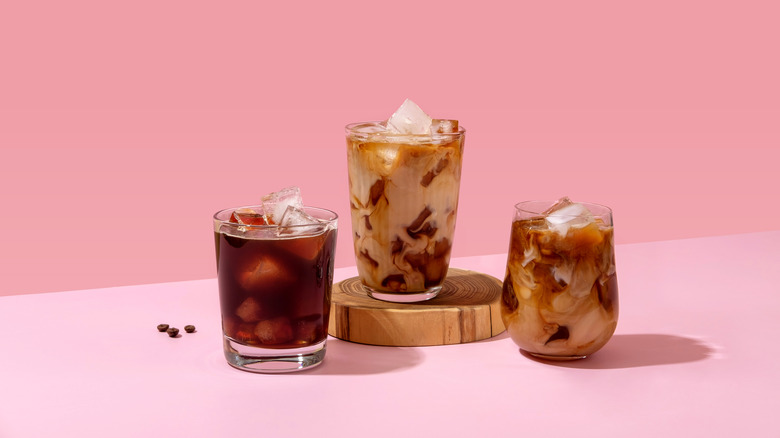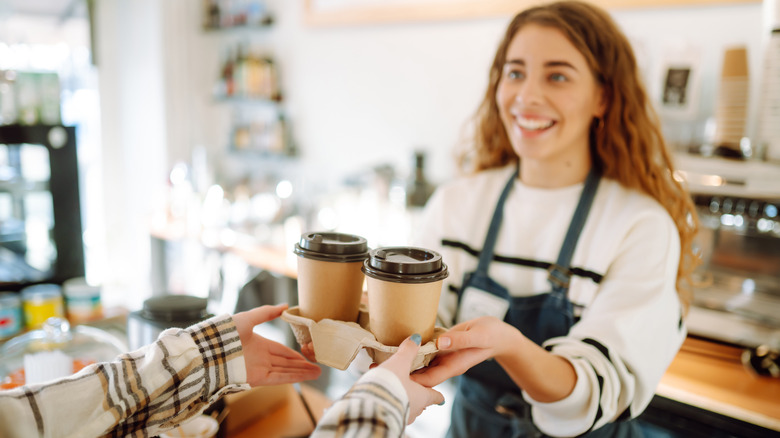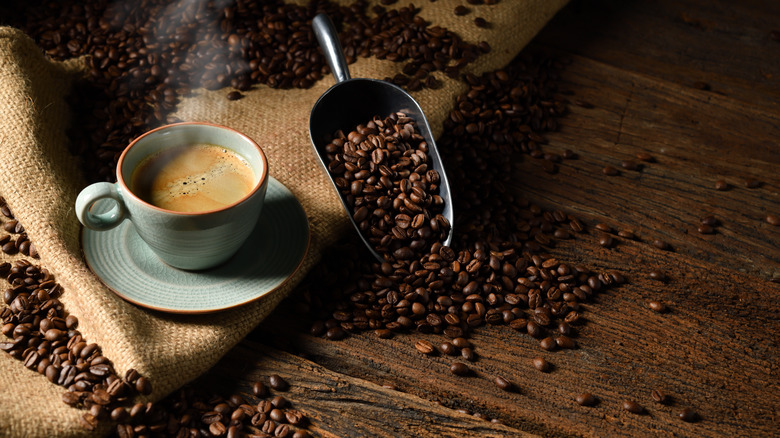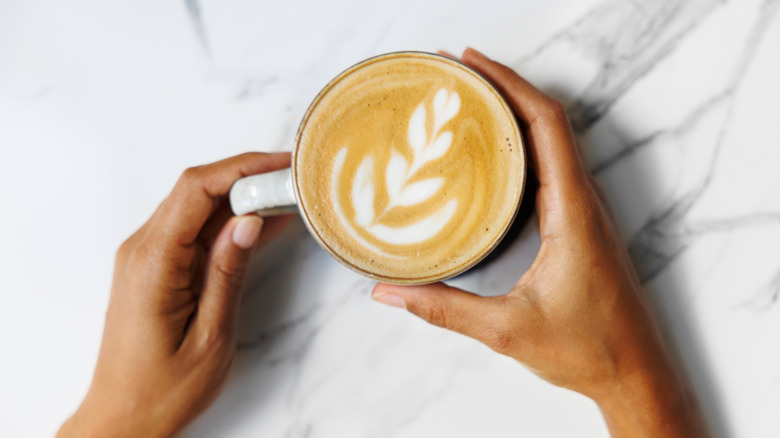10 Things You're Doing That Annoy Your Barista
Baristas are amazing beings. They provide our precious morning caffeine, wait patiently while we dither between a grande and a venti, and are constantly coming up with new ways to make our favorite brew even more delicious. However, even the most professional baristas have their limits and sometimes customers push these boundaries without even realizing. If you've ever noticed a covert eye-roll as you scan the board or a less-than-enthusiastic response when you order a soy cappuccino with extra foam, this list could be for you.
Matt Woodburn-Simmonds, the owner of Home Coffee Expert, knows all about barista pet peeves and the challenges that come with manning a busy bar. To find out how you can stay on your barista's good side, we asked Matt about some of the most aggravating customer behaviors that he sees regularly. From holding up the queue to making unreasonable demands, these 10 habits will annoy your barista.
1. Placing overly complicated orders
Customization is all part of the fun when it comes to ordering drinks from Starbucks or finding your perfect pick-me-up. Many coffee chains offer thousands of options specifically so that customers can tweak their orders. Most baristas are more than happy to make your brew exactly how you like it. However, some customers take this to the extreme.
Coffee expert and long-time barista Matt Woodburn-Simmonds explains, "It's surprisingly rare for people to order drinks strictly from the menu." However, problems can arise when customers make endless changes to their order as this can slow down preparation time. "Anything up to 5 changes is fairly standard and something you get used to," Woodburn-Simmonds says, "once you're past 5 it becomes really time-consuming."
So, bear in mind that the more complicated your order is, the longer it will take to make. This goes for the type of coffee you choose as well. For example, some coffee extraction techniques take 3-4 minutes to complete, so don't pick a pour-over if you've only got two minutes to grab your drink and make it to the bus stop. If you've chosen an elaborate coffee, be prepared to wait patiently and give the bar staff enough time to make it properly.
2. Coffee made for social media
Beautiful coffee art is a wonderful bonus and something that many baristas pride themselves on mastering. Not only does it allow bartenders to show off their skills, but coffee art is also an important piece of branding for shops and chains. It lets them infuse their coffee with a signature, social-media-friendly look. Matt Woodburn-Simmonds notes that some level of coffee art — such as layering lattes or adding a foam heart to a flat white — has been integral to barista culture since the mid-2000s.
However, "drinks that are supposed to be in the plastic cups all layered up for Instagram or TikTok are incredibly irritating," adds Woodburn-SImmonds. With coffee art social media trends growing steadily more popular from 2015 onward, it can sometimes seem like coffee drinking is now largely about aesthetics, rather than about quality and taste. As Matt explains, spending extra minutes on a drink just to get the perfect layering effect can feel like a waste of time for baristas, "especially since you're instantly going to stir it up to drink it."
3. Ordering your coffee extra hot
Asking bar staff to make coffee "extra hot" is a pet peeve for many baristas. Not only do you risk burning the milk or changing the coffee flavor through overheating, but you also run the risk of scalding yourself — not something anybody wants to see happen on their shift. "Coffee and milk are served at the temperature they're served at for maximum enjoyment," Matt Woodburn-Simmonds states. "It's not an arbitrary number picked from thin air."
The ideal temperature for extracting flavor from coffee is generally believed to be between 200 degrees Fahrenheit – several degrees below water's actual boiling point. Extraction using boiling water draws out more acidity in the coffee, which can lead to a bitter flavor. What's more, the milk for your coffee ideally shouldn't be heated above 149 degrees Fahrenheit. Steaming milk to the point where it boils can scald the creamy flavor and make it impossible to create foam bubbles that will hold together in a froth.
4. Not knowing the the proper coffee terms
No one is going to argue that coffee is a simple subject. The range of brewing methods and preparation techniques is mind-boggling once you start to explore. Still, if you're going to place an elaborate coffee order, make sure you know what you're asking for.
Matt Woodburn-Simmonds notes that having a basic "lack of understanding of what you're ordering" is one of the quickest ways to aggravate your barista, adding, "Being asked for a 'dry cappuccino,' which is basically a double espresso macchiato, [...] is just tedious." A traditional cappuccino is made with one-third milk and one-third foam, while a dry coffee only has foam and very little milk.
Baristas want to make you the right drink. It's easier for you, it makes them look good at their job, and it saves everyone time and hassle. Still, with so many coffee varieties on offer and a lack of common terminology about certain drinks, confusion can easily arise. So, if you don't want to annoy your barista but you aren't up on your coffee terms, try chatting to them about what you want or ask politely if you want your order changed. Just don't immediately jump to the conclusion that your barista is at fault if you're not 100% sure what you've ordered.
5. Asking for an extra strong single espresso
This is another case of customers not fully understanding their coffee order or the options available to them — something that most baristas will be happy to explain. On the hunt for a serious caffeine hit, some customers will demand a single espresso "extra strong" without realizing that a double espresso is a better option in terms of strength and flavor. Matt Woodburn-Simmonds remembers one "regular customer" who'd place this coffee order every day, despite Matt trying to explain that they had "dialed in the machine to deliver espresso a certain way."
A common misconception in the coffee world is that, because a single espresso is smaller than a double, it must be a more concentrated, stronger drink. The increased liquid volume in a double espresso seems to suggest that it's a single espresso that has been watered down. However, a double espresso is poured through a larger coffee shot (14-18 grams), meaning that it extracts more flavor and more caffeine than a single espresso, which is around 7-9 grams of coffee grounds. As the standard pour size in many U.S. coffee shops is now a double pour, you can ask for a single espresso when you want a less caffeinated drink.
6. Ordering foam on a low-fat coffee
Steaming milk to create the perfect cappuccino froth is something of an art form. Instead of simply boiling the milk to create bubbles, pro baristas aim for a rich foam that holds its shape. If the air bubbles in your steamed milk are too large, they will burst quickly, leaving you with less volume in your coffee and a light, dry foam texture instead of a full, creamy one.
Whole or 2% fat dairy milk is the most conducive to proper foaming as the fats and proteins in the milk cling to the air bubbles, giving the froth a dense, creamy texture. Dairy milk also contains lactose, which breaks down into sugar and sweetens the milk as it heats. While a skilled barista can achieve a pretty convincing froth with non or low-fat milk, Matt Woodburn-Simmonds admits that it's a hard skill to master. "Anyone who wants a skimmed milk cappuccino or almond milk or oat milk makes your life so much harder as getting that nice, dense microfoam is an absolute nightmare with those milks."
While there are plant-based alternatives — such as the Oatly Barista range — that add extra oil for a thicker, creamier product, these can still be hit or miss when it comes to foam. As Matt notes, "Sometimes it takes multiple attempts and you just don't have the time for that during the rush."
7. Are you sure that's decaf?
Hardworking bar staff often hear this phrase from suspicious, caffeine-avoidant customers. If you're giving caffeine a hard swerve, you've probably got a good reason for this, however, being asked "Are you sure it's decaf?" is a particular annoyance to professional baristas. "The lack of trust from decaf drinkers is deeply irritating," Matt Woodburn-Simmonds says. He notes that it's frustrating to have customers "constantly questioning "Are you sure that's decaf," "This better be decaf," and the classic "If I'm up all night then I'm coming here to complain" — it's really not difficult to use decaf beans to make your drink."
Despite the pervasive idea that baristas and coffee experts hate decaf drinkers, in reality, decaf is a common order and can be just as delicious as caffeinated coffee. Many people opt for decaf to avoid the unpleasant side effects of caffeine, such as increased anxiety or difficulty falling asleep. Some small flavor changes, such as becoming slightly milder, do occur in the decaffeinating process, however, most bar staff certainly won't go out of their way to sabotage your order or dose you with caffeine just because you order something that's not their preference.
8. Asking for 'light ice' in an iced coffee
Iced coffee drinks have become increasingly popular since the 1990s and are now a standard order in large coffee chains. Starbucks sales report suggests that the coffee giant sold more cold drinks than hot during the summer of 2022. Dunkin' Donuts offers a huge range of iced drinks, from cold brews to traditional coffee served over ice, as does the popular coffee chain, Dutch Bros. Baristas are often big fans of these cold coffee drinks and are happy to offer customers a wide variety of drinks to choose from.
However, Matt Woodburn-Simmonds notes that one barista pet peeve specifically relates to this new iced coffee trend. "Iced drink annoyance is that some people ask for "light ice", meaning the amount of ice from the smaller size of the drink so less ice in the cup (tall scoop of ice in a grande cup), and then expect to get more coffee," Ice adds volume to your drink so if you order a large iced coffee and then ask for less ice, your cup won't look as full. However, most baristas won't top you up for free with coffee when other customers have to pay more for the larger size.
9. Choose your drink before you join the queue
Baristas, like all catering professionals, are used to working under pressure. They can knock up a speedy macchiato or an in-minutes mocha whenever it's required. However, if you have no idea what to order and you want time to peruse the menu, don't join a busy queue or stand at the counter when staff are falling behind. According to Matt Woodburn-Simmonds, this coffee shop faux pas has more to do with picking your moment than wanting to rush customers through their order.
"The time to ask questions or stare at the menu thinking is not at the front of a huge queue during peak times," Matt states. When you're holding up other customers, you're most likely going to annoy them and irritate the bar staff, who will then have to deal with the angry queue. Dithering is also a big no-no if the bar is visibly understaffed. If you really can't decide, just step to one side to read the menu or wait until the rush dies down to ask the barista if you're unsure.
10. Don't be rude or a coffee snob
If you share a passion for coffee with your local barista, chances are they will be more than happy to discuss high-quality grinds and flavorsome roasts with you. However, if you're just there to show off how superior your coffee knowledge is, don't expect to be given the warmest of welcomes. Matt Woodburn-Simmonds observes that, while he is a self-professed "coffee lover" customers "getting snobby about coffee in a cafe is extremely tedious and irritating." Baristas already work hard to ensure that customers are attended to, so they're generally not best pleased to receive a lecture on their area of expertise while they're at work.
Woodburn-SImmonds notes that some customers may have genuine concerns or "ethical issues" with how the coffee is sourced at certain chains or bars. However, if this is the case, he encourages customers to "go somewhere else" rather than bring it up with the bar staff, who are often not in a position to make company-wide changes. Matt also highlights the importance of being generally respectful to your barista. Customer service can be a tough industry and polite customers are always the barista's faves.
Methodology Slide
To research this article, I relied heavily on the expert advice of Matt Woodburn-Simmonds of Home Coffee Expert. I also drew upon my own experience working as a barista and found a range of internet sources to help me expand my coffee knowledge.
